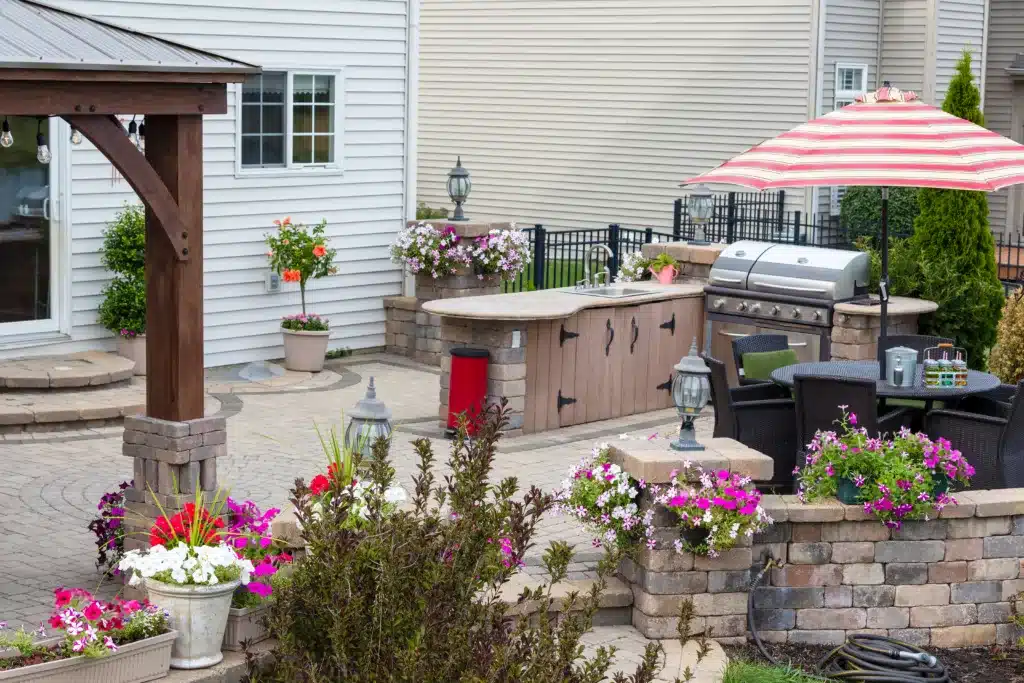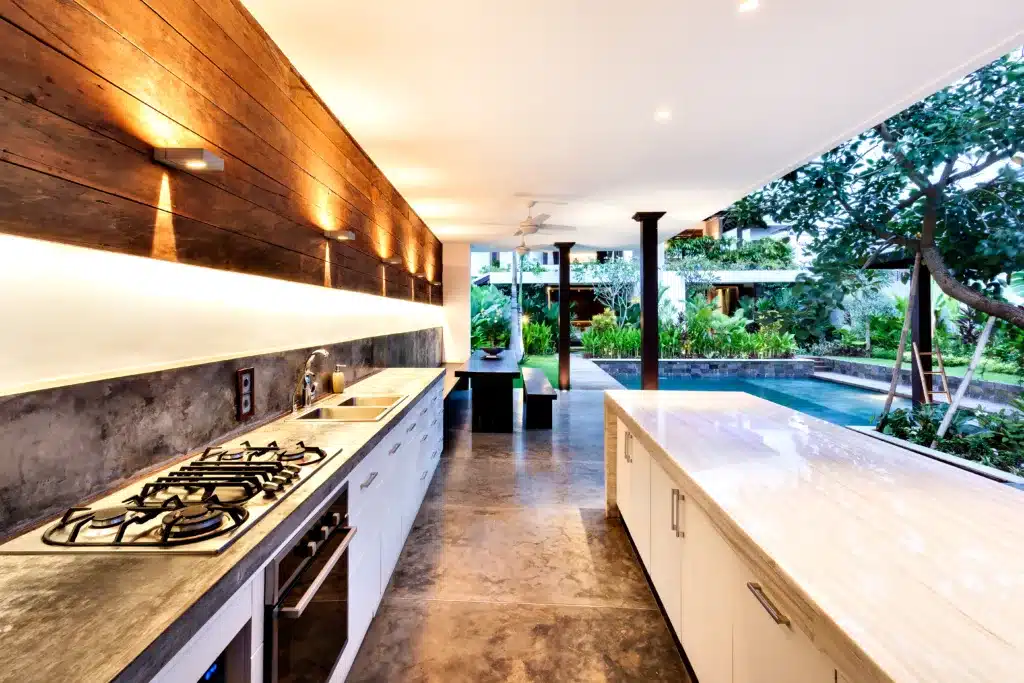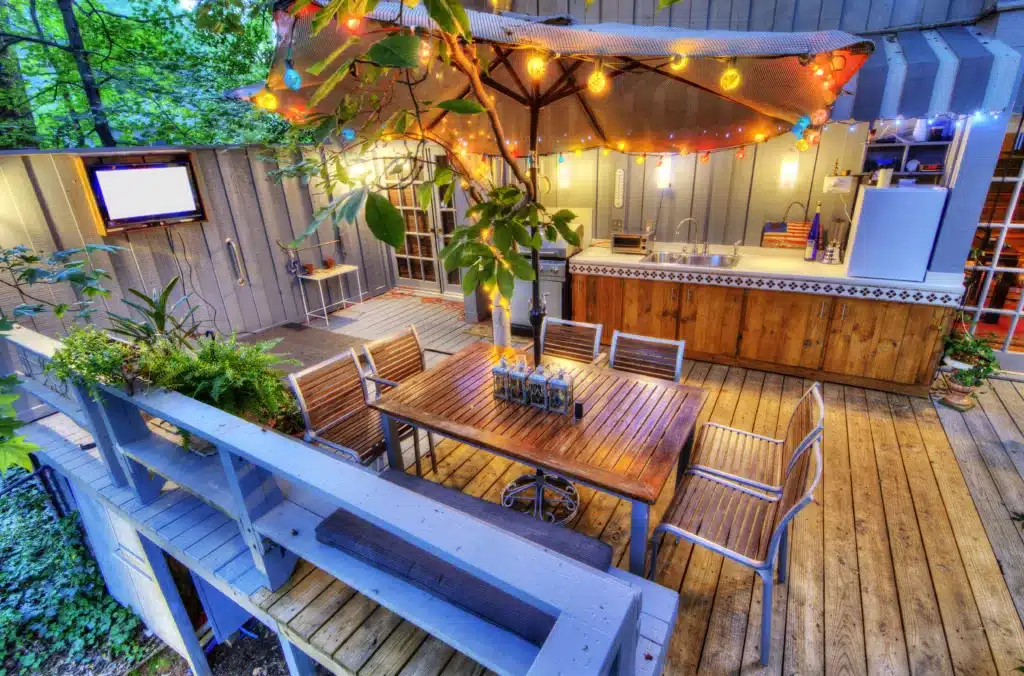Installing outdoor countertops is a luxurious option for extending your dining space. Countertops on a patio can be paired with a grill, stove top, or even sink. When choosing the right outdoor countertops for your property, your first consideration should be durability. Design and appearance are secondary if you don’t want to lose your investment.

What Type of Countertop Is Best for Outdoors?
Outdoor countertops come in many different materials. Again, if you are primarily selecting the right outdoor countertops based on durability, your three best options are natural stone, concrete, or tile.
Natural Stone
We start our list of durable natural stone choices with granite. Granite is highly durable, bearing up against the most foul winter weather. It is also resistant to heat, a desirable quality whether you are working with hot pans or hours of direct sunlight. If properly sealed on a regular basis, granite can resist staining and biological threats like mold and mildew (a real consideration out in the rain).
Soapstone also holds up well outside. It shares many of granite’s qualities, including resistance to heat, stain, and microbes. It bears up well under acid conditions, which is one of the things that makes it such a popular choice in kitchen settings. While the color choices of soapstone are limited, it has one advantage over granite. Soapstone is not porous, so regular sealing such countertops isn’t required.
Marble isn’t the best material for outdoor countertops, but those who love the stone can make it work. Marble has to be sealed regularly if you want to keep it looking fresh, especially when it is installed outside. While marble may not be the right outdoor countertop choice for your space, if you love the way it looks, consider quartzite. Quartzite has many of the same characteristics as granite, and maintenance is minimal.

Concrete
Concrete is a common choice for exterior countertops. The material is quite durable and can be poured into many shapes, making installation accessible no matter the dimensions of your outdoor space. Concrete countertops have a clean, contemporary look that many prefer. Concrete is common for other exterior surfaces like driveways and patios, so many consider it the right outdoor countertop material too.
There are a few risks involved when opting for concrete countertops. The material can crack if not installed correctly, even if it is reinforced with tensile steel. The way to avoid this problem is by working with the right installer. Find someone with ample experience and a wide variety of color choices. Concrete, like other materials on this list, must be sealed at the time of installation and resealed on a regular basis.
Tile
Tile is perhaps the most versatile countertop material available, offering a range of style options. Tile can be fashioned to look like other materials, or it can be arranged in intricate patterns and designs. Tile is very often among the most affordable countertop materials, and it lends itself most easily to DIY installations.
Tile has its own risks that make many wonder if it is the right outdoor countertop for them. For one, the grout between tiles can stain even if it has been sealed. Darker grout will minimize stain visibility. Grout and tiles risk cracking during freeze-thaw cycles in colder climes, so using the right materials for your area is essential. Waterproof board makes a better base, and porcelain or freeze-proof tile is better than ceramic.

Materials to Avoid
Clearly not all outdoor countertop materials are created equal. Quartz, though it is a natural stone, tends to discolor in the sun as the synthetic resin yellows under UV exposure. Laminate countertops are made from particleboard and are prone to warp or harbor mold. The pigments in recycled glass are not usually designed to hold up in outdoor use, so such countertops can fade or discolor quickly. Speak to your countertop installer before setting your heart on the right outdoor countertop material for you.
What Is the Right Outdoor Countertop Depth?
The right outdoor countertop depth is often a matter of preference, but there are some suggestions within the industry. You will need to work with the space you have available on your patio or in your backyard, leaving space for walkways and navigating the countertops. Consider what you want to use the space for—that will give you a better idea of how much countertop space you need.
Bar tops are typically 12 inches at the bare minimum, ranging between overhangs of 12 and 18 inches. Counters for other applications are usually closer to 24 inches. As far as length goes, bar tops will need at least 6 inches between each bar stool. If the stools swivel, that distance should be increased to 8–11 inches for comfortable movement.

